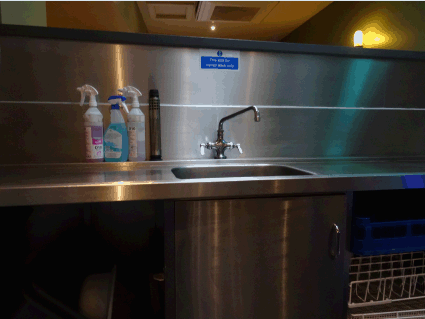
A mass food poisoning outbreak was caused at a convention over 200 people who attended the convention reported to have been suffering with food poisoning and 24 people were hospitalised.
An investigation into the cause of the outbreak revealed that the people who were poisoned had the same strain of salmonella that was found on a kitchen stick blender that had not been cleaned correctly and was poorly sanitised. Although cooking food at high temperatures does kill the bacteria, on this occasion the salmonella was not killed because the cooking temperature was not high enough, instead the bacteria was “incubated”.
A further investigation into the kitchen where this outbreak took place, found not only salmonella on the kitchen stick blender and a large food mixer, but also E-coli, and Bacillus Cereus (B. cereus) were found on a separate mixer, pastry brushes and whisks.
These harmful bacteria’s were all present at this establishment due to a breakdown on cleanliness, a lack of sanitizing the equipment, and staff not washing their hands correctly or often enough.
To prevent another harmful outbreak the general manager of the establishment has advised that the mixer has been removed and whole eggs are no longer on the menu, which means there are no egg shells, which potentially carry pathogens, will ever come into the kitchen.
If you are working in an environment where you are handling food you have a responsibility to the public to ensure that the food that you are serving them is safe and free from foodborne illnesses such as salmonella and E. Coli.
Salmonella is one of the most common causes of food poisoning. People can get salmonellosis by eating food contaminated with salmonella if an infected food handler had not washed their hands with soap before handling food products.
Salmonella can also be passed from meat products to vegetables if you are preparing vegetables with the same equipment that was used to prepare the infected meat.
There are many strains of E. Coli, thankfully most of them are harmless to humans, however, if you are handling raw fruit and vegetables, it is important to skin / wash them before use. Again, if you are preparing meat, such as beer, be sure not to use the same utensils or chopping board for cooked, uncooked meat and vegetables.
It is important that the employees in your kitchens are washing their hands regularly, before they start work, before food preparation, and after handling raw products.
Here at Label Source we know that kitchens are full of hazards. We have a comprehensive range of mandatory kitchen safety signs will help prevent the contamination of food prepared in your kitchen by helping to identify potential hazards, and encourage best practises from your staff.
All of our Kitchen Safety signs are made to meet the ISO EN 1710 standards and comply with the General food hygiene regulations 2010.
Click here to View our comprehensive range of Kitchen Safety Signs.
In the unlikely event that you cannot find the safety signs that meet your specific requirements then please contact us on 0800 3761 693 or email info@labelsource.co.uk and a member of our customer service team will be happy to assist you.